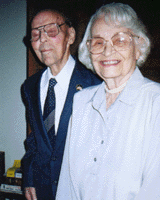
Pat Moore
is honored with a Brick from Liz Hicks, Ruby Kuhns, and Jean Postlethwaite - deceased.
 On January 28, 1917, Hazel Smith entered the world at Nelogany, Okla. The town disappeared in a nitroglycerin explosion and Hazel evolved into Pat Moore, only a little less noisily.
On January 28, 1917, Hazel Smith entered the world at Nelogany, Okla. The town disappeared in a nitroglycerin explosion and Hazel evolved into Pat Moore, only a little less noisily.
The Pat most of us know and admire convened the Grey Panthers of Wichita in 1981. That Pat became a community treasure as she appeared at numerous local forums and spoke out on many issues. That Pat served on the National Grey Panther Advisory Board and chaired the National Grey Panther Advocacy Committee which decided what class action suits to pursue through the National Senior Citizens Law Center. She seemed to appear, like Athena bursting from the forehead of Zeus, completely formed and suited to her tasks.
But the person known as Hazel Smith spent her childhood in the Great Depression with a father who believed that he had to "pound sense" into his children literally. The "oldest son" in the family, Hazel learned to chop wood, repair roofs, and fish. She also learned that her brothers were more valued than her sisters were. She was surrounded by racism, sexism, and a family of fundamentalist preachers.
But all that was offset by the influence of her maternal grandmother, Aurelia Wiggins, who told her frightened granddaughter stories. Those stories wove a conscience in the young girl, which gave her the strength to overcome parental antipathy, an abusive husband, civic and cultural wrongs, and the plight of being old and poor. One of those stories involved her grandmother, a child of slave owners, being given a slave maid for her coming-out party. That slave was also her half sister. She tore up the ownership papers and broke with her twin brother and the rest of the family. She loved to remind people not to use the word "Nigger" since they might be referring to relatives!
Pat chose her husband "with my glands, not my brains." Not long after they were married, he began abusing her. "For 35 years," she remembers, "I lived with a man who beat the hell out of me every time I didn't breathe right." When she called the police for help, they told her to quit doing whatever he beat her for. He held another threat over her head. Men could have their wives declared insane and committed. Her sister's husband had done that and left the woman a "mindless, blithering idiot" after electric shock treatments. Pat took that threat seriously.
Although she felt thwarted, she found ways to impact her community. She tricked her husband into buying a house in the middle of the black community so that their son could attend Little School, the first integrated elementary school in Wichita following Brown Vs. Board of Education, the Topeka Supreme Court decision which struck down the "separate but equal" schooling plans. She also became active in Brotherhood Presbyterian Church and networked with friends from Wichita State University, Friends University and the Unitarian Church. Their project was to create neighborhood integration by helping black families move into previously all-white neighborhoods. They battled the ingrained red-lining of neighborhoods successfully for a number of families.
Because she had been told by her father and by her husband that "Women are no damn good for anything but the pleasure they can give a man!" Pat worked hard to make sure she knew what she was talking about. She studied facts and opinions with an analytical mind. An example of her thorough examination of facts led to her nickname. In high school debate class she presented a well-formed argument. Her opponent gave what she perceived to be a poor response. When the teacher asked her to rebut, she responded, "I stand pat." "Pat" stuck and later she had her name changed legally.
Throughout the years that she hid her opinions and thoughts from her husband, she was accumulating an enormous array of political data bank. Following his death and her subsequent realization that she could now speak her mind, she was invited to join the Turnip Club where she could engage in lively discussion with interesting people. She credits Mary Pratt with forcing her to define her arguments accurately. Those experiences reminded her that she did have something to say.
And so, when she saw Maggie Kuhn on television, saying all the things that Pat thought should be said, she wanted to associate with her. In her usual thorough fashion, Pat studied all the rules governing chapters for a year before sending out invitations to meet and discuss forming a chapter. Following the first meeting, a reporter asked to interview Pat. Pat then interviewed the reporter, asking how she could get her messages out. She learned the art of the "sound bite," formulating exactly how to say her messages and then to shut up.
Pat was asked to step in as a speaker for Gray Panthers when Maggie Kuhn was overbooked. Maggie once told Pat that she "thinks more like me than anyone else I know." Even after Pat's first heart attack stopped most of her activity and Maggie's health declined, they remained phone friends.
It's not common for a woman to overcome personal adversity and become known both locally and nationally for speaking hard truths. So we admire and thank Pat for being a "She-ro."
Submitted by Jean Postlethwaite, Ruby Kunhs and Liz Hicks; compiled by Liz Hicks
September 5, 1998










